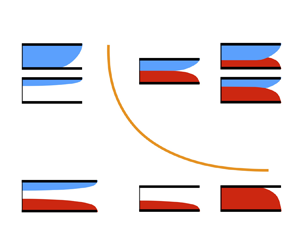No CrossRef data available.
Article contents
The interaction of gravity currents in a porous layer with a finite edge
Published online by Cambridge University Press: 04 September 2023
Abstract

The interactions of upper (lighter) and lower (heavier) gravity currents are closely related to fluid-phase resource recovery in porous layers and cleaning of confined spaces. The addition of a second current increases the sweep efficiency of fluid displacement. In this paper, we first derive two ordinary differential equations to describe the interaction of gravity currents in the quasi-steady regime. Two asymptotic regimes are identified, characterised by whether or not the two currents attach to each other, depending on whether the source fluxes are large enough. In the attached regime, a symmetry condition is also identified that describes whether or not the pumping and buoyancy forces balance each other. The model also leads to analytical solutions for the interface shape of the interacting currents in both the detached and attached regimes and for both symmetric and asymmetric currents. For symmetric currents, analytical solutions can also be obtained for the pressure distribution along cap rocks and the sweep efficiency of flooding processes. A particularly interesting aspect is that the displaced fluid remains quiescent at any steady state, regardless of whether the currents attach to each other. Correspondingly, the interface shape of the currents can be described by relatively simple equations and solutions, as if the currents propagate independently in unconfined porous layers. Time transition towards quasi-steady solutions is provided, employing time-dependent numerical solutions of two coupled partial differential equations for dynamic current interaction.
- Type
- JFM Papers
- Information
- Copyright
- © The Author(s), 2023. Published by Cambridge University Press



